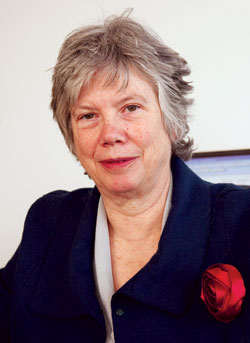English professor studies landmark book on women's health
|
Today, many of us know Our Bodies, Ourselves simply as a popular series of handy guides to women’s health. But, in fact, the book is credited with revolutionizing the way women think about their bodies and with transforming the doctor-patient relationship. According to Temple English Professor Sue Wells, the text established an entirely new way of talking about the female body and the scientific and medical disciplines that attend to it. Wells explores the development of this new discourse in her book, Our Bodies, Ourselves and the Work of Writing (Stanford University Press, 2010). First published in 1973, OBOS grew out of a small discussion group on “women and their bodies” in 1969 Boston and by 1999 had sold more than 4 million copies, been translated into 29 languages and generated numerous related projects. “Whether or not the authors saw themselves primarily as health activists, this is a story of amazingly successful and incredibly productive writers. There are few examples of writers who work in partnership — and this was a group of 12 that collaborated for 40 years,” said Wells. “Sure, the 60s were ‘sex, drugs and rock ‘n roll,’ but it was also a time of intense intellectual work. These women worked really hard to produce writing that was extremely consequential. I wanted to tell the story of these women as writers, because that’s what they were,” she said. The Boston Women’s Health Collective — the group formed to write OBOS — emerged at a time when there was widespread participation of women in higher education, but not a lot of career opportunities. “The women in this group were highly educated and highly literate — they were, as they say, all dressed up with no place to go. In some ways, their book was a response to the question of ‘Now, what do we do with our education?’” she said. OBOS was the first book for women on taking care of themselves. In it, readers were encouraged to trust their own experiences and to participate in a conversation about their medical care for the first time. “The authors presented medical information by telling stories — a strategy that challenged the relationship between expert knowledge and personal experience and suggested to women that they could trust themselves,” said Wells. For her research, Wells waded through 200 cardboard file boxes from the Collective’s archives and interviewed the writers. Even 40 years later, many could still remember the thinking behind particular word choices, such as the use of “shall” in the chapter titled “Shall I become a mother?” According to Wells, the writers opted for the formal “shall” because “should” would seem to cast judgment. This intentionally neutral approach to presenting information was a unifying theme and a key to the book’s impact. Also intentionally neutral were the illustrations, showing women at ease with their bodies. “The photos were unsentimental, unsexualized and explicit — a graphic and matter-of-fact display that invited women to take a look at themselves in the same non-judgmental way,” said Wells. “Reading OBOS was like wandering into a room where women were sitting around, like people do, talking about this medical procedure or that, but with women who had done an incredible amount of research,” said Wells. “The book powerfully positioned the reader as a discoverer of new territories and the writer as her ally.” |
